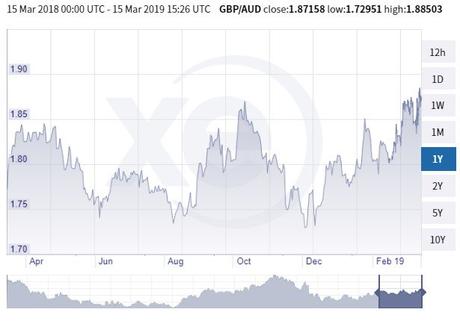The Pound-to-Australian (GBP/AUD) Dollar exchange rate moved to a near a four-month high at 1.8688 at due to the Brexit process going as planned and seemingly Aussie-negative news out of Asia.
The AUD weakened on Thursday in response to signs of a further contraction in the Chinese manufacturing sector during February. China’s economic problems directly impact upon the domestic Australian economy. This will always be a concern for the Australian Dollar because the currency is substantially underwritten by a large bilateral commodity trade with China, therefore giving it a strong positive correlation with the Renminbi. A large percentage of resources sold to China is consumed by the manufacturing sector.
The exchange rate is quoted at 1.8688, having been as high as 1.8695, a level that represents a near four-month high. When the rates are volatile and you need to move money cross border, these are the times to take advantage of the fluctuations.
Given the weak state of the Chinese economy and doubts over the trade war truce between China and the U.S., a poor GDP number could see the Australian Dollar succumb to a cocktail of negative sentiment next week.
Regarding the trade war, President Trump said tariffs on some Chinese exports to the U.S. will no longer rise to 25% in March, as had been planned, because (apparently) negotiators are making progress in talks to end China’s “unfair trade practices. Numerous commentators are sceptical of the progress in talks and aren’t confident that any deal will be sufficient or honoured in the long term by both sides. Over the timeframe that talks have been ongoing, the AUD has been choppy and is at its weakest since earlier 2016.
GBP/AUD from the last 6 months

However, during the final quarter last year Australia’s economy grew by 0.2%, down from 0.3% back in the previous period. GDP rose by only 2.3% for 2018 as a whole. In the stock markets, an aggressive bear market took place at the same time.
It’s beneath the RBA’s (Reserve Bank of Australia) February 2019 forecast for a steady 2.8%, with much of the deceleration having its roots in the household sector. Economists are connecting Australia’s slowing economy with an ongoing downturn in house prices, linked strongly with household confidence and consumers’ willingness and ability to spend.
“Sub-par growth adds to below-target inflation and a housing sector that continues to deflate, posing the possibility that the RBA’s pivot to a neutral bias in February is already out of date.” According to Tom Nash of HSBC. We must note HSBC has been selling the Aussie ever since the early days of January.
It’s not solely down to a weakening domestic house sales markets, global factors may well have been what hurt the Australian Dollar but the FX team at HSBC say further drops can be attributed by events in the domestic economy.
In a bid to stem the loss and try and simulate the economy, the RBA said that it would cut interest rates if unemployment rises in a sustained manner. Markets are already betting there is a high probability the RBA will cut its interest rate by up to 50 basis points over the year. That said, it could rise further and force the Australian Dollar lower in the process.
“Our Labour Market Indicator points to a period of stability for the unemployment rate rather than a sharp jump higher. If this is right, we think the RBA will look through weak GDP prints, though it will be an uncomfortable time,” Citi commentated.
The RBA has held its interest rate at a record low of 1.5% for more than two years now because of “below target inflation” as well as an economic outlook that means wage pressures are unlikely to be sufficient enough to lift the consumer price index to within the 2%-to-3% target band.
January trade data
The Australian Dollar recovered off earlier lows last week after official data revealed a sharp increase in the January trade surplus, which gave support to the AUD even after other figures showed household spending growth was lowered than expected. A short-term rally from day traders came on in support of the news but many expect fresh lows from the Aussie dollar.
Australia’s trade surplus was $4.55bn in January rising from $3.77 bn previously. Markets expected a decline to $2.85 bn. This was the second largest surplus on record, which came after exports grew faster than imports in the New Year. Imports of goods and services rose by 3% to $35.38 bn in January while exports rose 5% to $39.93 bn although much of the latter increase was due to improved international demand for gold. Australia has many successful gold mines and producers and numerous junior explorers continuing to literally strike gold.
Trade balance data measures the difference in value between a nation’s imports and its exports. Currency markets care about it because the data provides insight into supply and demand of currency in the “real economy”, while also giving a steer on the likely pace of GDP growth in a given period.
Generally speaking, a narrowing deficit suggests either that exports and their associated demand for currency are rising, or that imports and their associated supply of currency are falling. Both are typically good for currency while a steadily narrowing trade surplus, or a widening deficit, is a negative influence.
AUD/USD pair lifted back towards 0.75 in the Asian trading session because of the Australian January trade surplus rose to its second highest level on record. The strong trade data more than offset the impact of lower than expected January retail sales.
“The latest GDP data for Australia reinforce our view that the RBA will be forced to cut rates before long. With this in mind – and given our expectations that the housing downturn will deepen; commodity prices will fall; China’s economy will slow, and appetite for risk will wane – we think that the Australian dollar and the ASX 200 will slump this year,” a cheery Simona Gambarini of Capital Economics commented.
It’s no secret that Australian policymakers and markets have long been concerned about the impact that house price cooling could have on consumer spending and economic growth. RBA Governor Philip Lowe warned that with home prices down 9% in the last year, they could still have further to fall meaning household spending decline and savings begin to rise. The first victims of this change to the economy is generally luxury and discretionary consumer goods such as cars, household goods and high-value items such as furniture.
Regarding the currency weakness, the Australian treasurer Josh Frydenberg brushed off the currency movements, “goes up and down” because it is the fifth-most-traded currency in the world. Frydenberg attributed the shift to “a variety of factors”, including an increase in the official US interest rate and smaller trading volumes over the Australian summer but that’s only part of the story.
The China-US trade talks are the single most important event risk for the Australian dollar in the coming weeks. These need to yield an agreement to a reasonably comprehensive deal as a minimum for a recovery in global risk asset sentiment and a stronger AUD.
Michael Blythe, the chief economist at Commonwealth Bank of Australia, said: “The slowdown in the second half of 2018 reflects an array of negatives holding back consumer spending.” He pointed to the initial stages of a downturn in residential construction, as well as the slowdown in mining capital expenditure and the effects of a prolonged drought weighing on the economy. He continued that the poor economic news came at a time when markets were thin, because of the holidays. “It was a perfect storm in a way. Thin markets at a time when you get negative China and global news, so the Aussie dollar gets smacked around.”

